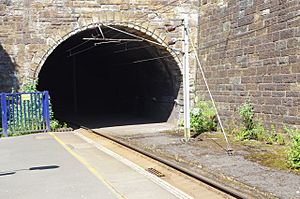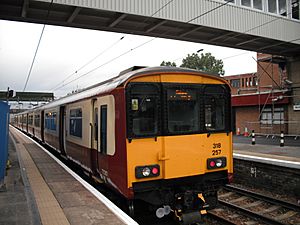Argyle Line facts for kids
Quick facts for kids Argyle Line |
|
|---|---|

Eastern portal of the Kelvinhaugh Tunnel, 2019.
|
|
| Overview | |
| Status | Operational |
| Owner | Network Rail |
| Locale | |
| Stations | 48 |
| Service | |
| Type | Heavy rail |
| System | National Rail |
| Rolling stock | |
| History | |
| Opened | 1979 |
| Technical | |
| Track gauge | 4 ft 8 1⁄2 in (1,435 mm) standard gauge |
| Electrification | 25 kV 50 Hz AC |
The Argyle Line is a busy suburban railway in West Central Scotland. It helps people travel around Glasgow and connects many towns. The line is named after Glasgow's Argyle Street. It uses an old tunnel that runs right under this famous street.
The Argyle Line is known for its wide network of passenger trains. It links towns and suburbs from North Clyde to places like Motherwell, Larkhall, and Lanark in the southeast. There are 48 stations on the line. These stations are spread across different areas of Scotland.
Contents
History of the Argyle Line
How the Line Started
An older railway, the Glasgow Central Railway (GCR), opened under central Glasgow in 1886. It connected many different railway lines. This original line closed in 1964. This was part of a big plan to cut down on railway lines, known as the Beeching Axe.
Opening of the Modern Argyle Line in 1979
The modern Argyle Line officially opened on 1 November 1979. Queen Elizabeth II herself opened it. This was a joint project between British Rail and the Strathclyde Passenger Transport Executive. They reopened and changed a 4.5-mile (7.2 km) low-level railway line. The name "Argyle Line" later came to mean the routes from Dalmuir to Lanark.
Building the Railway Infrastructure
The old railway line through Whiteinch and Partick was left unused. A new connection was built to the original North British Railway route. This new connection also included a special junction. It allowed trains to switch tracks without crossing others at the same level.
The railway lines were already electric in some parts. New tracks were laid and electric wires were put up in the unused sections. This linked the different parts of the network. A new platform was built at Rutherglen station.
Many parts of the line are underground.
- The brick walls in the tunnels were cleaned and fixed.
- Concrete slabs were used instead of traditional railway ballast (stones).
- Old stations like Glasgow Green and Glasgow Cross were not used. The entrance to Glasgow Cross station was turned into air vents.
- A new station called Argyle Street was built.
- Exhibition Centre station was rebuilt. It used to be called Finnieston.
- There are several tunnels along the line. These include Kelvinhaugh, Stobcross, Anderston, Canning St, and Dalmarnock Rd tunnels.
Flooding on the Line
In 1994, the River Kelvin flooded. Water poured into the Exhibition Centre–Argyle Street section. The water was over 3 meters (10 feet) deep. Two trains got stuck, and the line had to close for nine months. Dalmarnock station has also flooded several times.
New Extensions to the Line
The Larkhall Line opened in December 2005. It was an extension of the Argyle Line services. New stations were built or rebuilt, including Chatelherault, Merryton, and Larkhall. This part of the line has a single track.
The Whifflet Line service reopened in 1993. The Rutherglen–Whifflet section became electric in December 2014. This allowed trains to go through Glasgow Central Low Level. It also helped reduce traffic on other main lines.
How the Argyle Line Works
Railway Routes
When trains travel southeast from Dalmuir, they can enter the Yoker line. They can also stay on the North Clyde Line. This line goes through Singer and Westerton Junction. The Milngavie Branch line also joins here.
Eastbound trains go into the Kelvinhaugh Tunnel. This tunnel connects to an older railway section. You can even see the mouth of an old tunnel from the Exhibition Centre station platform.
Westbound trains go up a steep slope to join the North Clyde line. This line goes to Queen Street station.
The line also connects to the West Coast Main Line (WCML) after Rutherglen. The Whifflet line goes east from Rutherglen East Junction. The Hamilton Circle route also branches off. A 3-mile (4.8 km) branch line leads to Larkhall. The Hamilton Circle ends at Motherwell.
The line also passes through Bellshill. Further on, it joins the line from Whifflet. It then returns to the WCML at Motherwell. The line also reaches Lanark, which is the very end of the southeastern part of the line.

How Often Do Trains Run?
Trains run very often on the Argyle Line. Here is how many trains run per hour in 2020/21:
| Passenger trains per hour (2020/21) | ||||
|---|---|---|---|---|
| Terminus | Via | West of | Mon–Sat (off peak) | Sun (from 8:10am) |
| Dalmuir | Yoker | Glasgow Central Low Level | 4 | |
| Dalmuir | Singer | Glasgow Central Low Level | 2 | |
| Milngavie | Glasgow Central Low Level | 2 | ||
| Balloch | Glasgow Central Low Level | 2 | ||
| Passenger trains per hour (2020/21) | ||||
|---|---|---|---|---|
| Terminus | Via | East of | Mon–Sat (off peak) | Sun (from 8:20am) |
| Larkhall | Hamilton Central | Glasgow Central Low Level | 2 | 1 |
| Motherwell | Whifflet | Glasgow Central Low Level | 1 | 1 |
| Motherwell | Hamilton Central | Glasgow Central Low Level | 1 | 2 |
| Cumbernauld | Motherwell, Hamilton Central | Glasgow Central Low Level | 1 | |
| Whifflet | Glasgow Central Low Level | 1 | ||
Trains Used on the Argyle Line
When the Argyle Line first opened, new Class 314 electric trains were used. Older Class 303 trains also ran on the line. In the late 1980s and early 1990s, Class 311 trains were also used.
After 2002, the older Class 303 trains were retired. The line then used a mix of new Class 334 trains. Some older Class 318 trains were also moved to this route. The original Class 314 trains went to another line.
Today, the Argyle Line mainly uses Class 320 and Class 318 trains. Sometimes, you might see a Class 334 train. Class 385 trains cover services to Lanark. These trains now run into Glasgow Central.


